 AGFA MULTlCONTRAST PREMIUM
AGFA MULTlCONTRAST PREMIUM
AGFA MULTICONTRAST PREMIUM is a variable-contrast black-and-white
photo paper on resin coated base.
Characteristics:
-
MULTICONTRAST PREMIUM is an all-purpose B/W enlargement paper, whose
contrast can be varied with colour filters.
-
Features a similar contrast range to conventional fixed-contrast
papers, and so can replace the grades of conventional B/W papers.
-
When used with the special contrast control filters, it permits
simple exposure control without complicated exposure time conversions.
-
Can be exposed in all enlargers and printers, and processed
like conventional resin-coated B/W papers. Is suitable both for dish and
machine processing.
-
Achieves the same print quality as conventional B/W papers.
Consequently, even the most discriminating consumer can now enjoy the
advantages and convenience of a black-and-white paper with variable contrast
for all areas of pictorial photography.
The range
-
AGFA MULTICONTRAST PREMIUM MCP 310 RC glossy (natural high gloss)
-
AGFA MULTICONTRAST PREMIUM MCP 312 RC semi-matt
AGFA MULTICONTRAST PREMIUM is available both in sheets and rolls, in the
standard commercial sizes.
Special formats are available on request.
Minimal variations in the dimensions/sizes are possible - due to cutting
tolerances and expansion effects (to DIN 4506 Part 1 and ISO 1008).
Information on the black-and-white photo papers with fixed contrast
are given in the Technical Data sheet P-50-P. Infor mation on AGFA MULTICONTRAST
CLASSIC (variable contrast BW paper on fibre base) is summarised in the
Technical Data sheet P-54-P.
Packaging
The original packaging protects the paper from light and brief exposure
to humidity and fumes.
The inside packaging for sheets and rolls consists of lightproof PE
bags or PE foils. The outside packaging is an orange cardboard wallet or
a box with a tongued lid for sheets, and a corrugated cardboard tongued
box for rolls.
The outside packaging alone does not provide adequate pro tection from
light. Use both the inside and outside packaging for storing paper in opened
packs.
Emulsion number
A product coding is printed on the label. It consists of the five place
ABC code. This is followed by the emulsion number and some code
letters serving internal inspection purposes.
An internal order number starting with an X is printed on the second
line.
The first code line should always be given in enquiries and complaints.
The second code line provides helpful information for internal investigations.
Paper coding
Base weight, paper tint and surface characteristics are indicated by
a numerical code. This is as follows:
| 3 . . = |
polyethylene / resin-coated paper (RC) |
| . 1 . = |
white paper tint |
| . . 0 = |
glossy (natural high gloss) |
| . . 2 = |
semi-matt surface |
Example:
| MCP 310 RC |
= MULTICONTRAST PREMIUM,
RC/PE base, white, glossy |
| MCP 312 RC |
= MULTICONTRAST PREMIUM,
RC/PE base, white, semi-matt |
The labels are colour-coded as follows:
| RC paper |
= colour bar, crosswise orange |
| Surface 310 |
= colour bar, lengthwise mauve |
| Surface 312 |
= colour bar, lengthwise yellow |
A UPC bar code is printed on the labels (sheets).
Storage
Black and white photo papers should be kept cool, dry and protected
from harmful fumes. Temperatures under 20 C/ 68 F and a relative humidity
of 50 % to 60 % ensure that the papers will keep well over a very long
period.
Opened packs should be closed well after use (inside and outside packaging),
and if possible not stored in darkrooms or other wet rooms, only in cool
and dry areas.
The natural ageing process of photopapers is considerably retarded
by refrigeration or deep freezing. The paper must however be taken out
of cold storage some hours before use, and brought up to room temperature.
Paper design
Base
Sandwiched paper coated on both sides with polyethylene.
| Thickness: |
approx. 252 Nm |
| Weight: |
approx. 270 g/m2 |
Emulsion
The light-sensitive layer contains a fine-grain silver chlorobromide
emulsion.
| Silver content: |
approx 1 .5 g/m2 |
Protective layers
The two protective layers protect the paper from friction fogging and
physical damage.
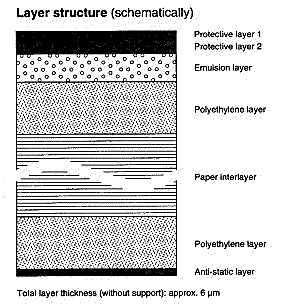
Maximum density
Both surfaces achieve at least the following maximum densities, assuming
that the exposure and development are correct.
MULTICONTRAST PREMIUM MCP 310 RC: Dmax = 225
MULTICONTRAST PREMIUM MCP 312 RC: Dmax = 225
| Density curves
Exposure: tungsten light 3000 K, time 10 s
Filters: contrast control filters 0, 1 , 2, 3, 4, 5 and UV blocking
filter
Development: AGFA MULTICONTRAST DEVELOPER Densitometry: read with visual
filter (V)
The exposure given in tux seconds applies to the combination of paper
and filter. |
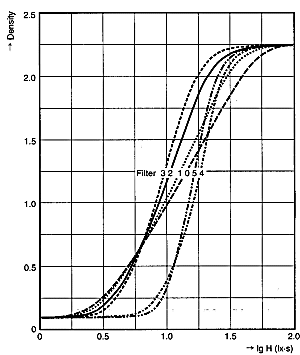 |
| Spectral sensitivity
(related to equal-energy spectrum)
The graph below shows the densities of 0.5 (I), 1 .0 (II) and 1 .5
(III) measured in reflection. The sensitivity is the reciprocal of the
exposure (in ml/m2) needed to produce the relevant densities. |
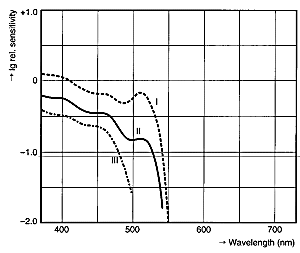 |
Sensitivity (speed)
(to ISO Standard 6846)
AGFA MULTICONTRAST PREMIUM has a speed of ISO P 400 when
exposed to white light (without filter). The contrast then reached
is about equivalent to the contrast with filter "2"
. If contrast control filters are used, the speed is:
-
for the "0" to "3'/z" filters = ISO P 160
-
for the "4" to "5" filters - ISO P 80
Halving the ISO figure corresponds to halving the speed, and doubling it
doubles the speed.
| Reciprocity
The reciprocity characteristics of AGFA MULTICONTRAST PREMIUM
are virtually unrelated to the filtration. The photo graphic speed falls
slightly as the exposures lengthen, while the contrast remains nearly constant. |
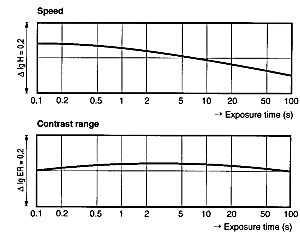 |
| Latent image
AGFA MULTICONTRAST PREMIUM has outstanding latent image features. The
speed and contrast remain virtually un changed, regardless of the filtering,
for a period of up to three days. |
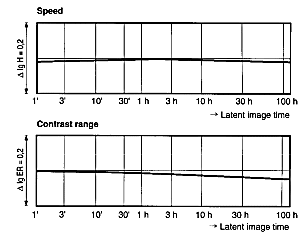 |
Exposure and contrast grading
AGFA MULTICONTRAST PREMIUM can be exposed on all standard enlargers
(with or without colour mixing heads), and on enlargers with special modules
for variable-contrast papers.
As can be seen from the spectral sensitivity curves (see page 4), MULTICONTRAST
PREMIUM is sensitized both for the blue and green spectral ranges. The
contrast grading is set by selective colour exposure:
-
Magenta filtration affects only the blue spectral range and
produces steep contrast.
-
Yellow filtration affects the green spectral range and produces
flat contrast.
The contrast grading can therefore be varied virtually continuously, from
extra-hard to extra-soft, depending on the blue and green light content
of the exposure.
The following methods are suitable for varying the contrast:
1. Standard commercial filter sets for variable-contrast black-and-white
papers
They are available as:
-
filter foils for use in the filter drawer
of the enlarger (in several formats), or
-
filter set with adapter for mounting under the enlarger lens,
or on the red filter pin of the enlarger.
The "0" to "5" filter designations correspond to the grade numbers of conventional
black-and-white photo papers. Each filter set includes extra filters with
intermediate values, for fine corrections.
The right grade is found by producing a series of test exposures with
different filters:
-
for contrasty negatives filters "0" to "1"
-
for negatives with normal contrast range filters "2" to "3"
-
for low-contrast negatives filters "4" to "5"
The filters are designed to require the same exposure time, as found by
testing, when the "0" to "3'/z" filters are used. This time has to be doubled
for the "4", "4'h" and "5" filters. If the exposure time is found with
the "4", "4'/z" or "5" filters, the time for a softer grade (i.e. filters
"3'/z" to "0") has to be halved.
Partial filtering
MULTICONTRAST PREMIUM offers the great advantage that individual areas
of negatives which are tricky to enlarge can be exposed with different
contrast control filters (e.g. for landscapes the sky areas with the "1
" filter, and the rest of the image with "4" filter). Partial re-exposure
and shading with filters will not only balance differences in brightness
within one negative, they will also produce partial variations in contrast.
Exposure without filters
MULTICONTRAST CLASSIC can also be exposed without filters. In this case
the resulting contrast grade is"2", and the speed is more than doubled
or the exposure time shortened by more than half .
2. Yellow and magenta filters in colour mixing heads
The manufacturers' filter density ratings are not identical. The exposure
time has to be converted or found for each filter. The entire contrast
range is not covered by some colour heads.
3. Vario-contrast modules
Vario-contrast modules with filters and computer logic are available
as add-ons for enlargers, to find the exposure time required in each case.
4. Colour printing filters (yellow and magenta)
The contrast of MULTICONTRAST PREMIUM can also be varied with the subtractive
printing filters in a printing filter set. The disadvantages of this method
are a partial reduction in the contrast range, and the necessity to convert
the exposure times.
Exposure on colour printers
AGFA MULTICONTRAST PREMIUM can be exposed on modi fied colour printers.
The equipment manufacturers provide special instructions for modification.
A suitable programme is already installed in the Agfa printers COLORMATOR
C 8 and COLORMATIC 30 MC, which permits the use of AGFA MULTICONTRAST
PREMIUM.
A "black-and-white process 135" kit (hardware and special software)
is available for the Agfa high-output MSP/MSP Plus printers.
Exposure on printers with pre-exposure systems
AGFA MULTICONTRAST PREMIUM can be exposed in usual BW printers with
a pre-exposure system (e. g. AGFA VARIOGRAD) without major changes to the
equipment. Fur ther informations on request.
Exposing and filtering MULTICONTRAST PREMIUM
| Grade and grade numbers as for graded papers |
ES
0 |
|
S
1 |
|
S*
2 |
|
N
3 |
|
H
4 |
|
EH
5 |
Real speed of
AGFA MULTICONTRAST PREMIUM (ISO 6846) without Filter |
ISO P 400 |
| Contrast control filters |
0 |
1/2 |
1 |
1 1/2 |
2 |
2 1/2 |
3 |
3 1/2 |
4 |
4 1/2 |
5 |
Effective speed of
AGFA MULTICONTRAST PREMIUM (ISO 6846) with Filter |
ISO P 160 |
ISO P 80 |
* Basic grade ("Special') of AGFA MULTICONTRAST
PREMIUM which can also be achieved without filtering. The effective
speed is then ISO P 400.
Filtration with colour printing filters or colour mixing heads
| Contrast control filter |
0 |
1/2 |
1 |
1 1/2 |
2 |
2 1/2 |
3 |
3 1/2 |
4 |
4 1/2 |
5 |
| Filtering with Kodak CP or CC filters * |
80 Y |
55 Y |
30 Y |
15 Y |
- |
25 M |
40 M |
65 M |
100 M |
150 M |
200 M |
| Filtering with Durst colour mixing head *(test with Durst
CLS 501 ) |
60 Y |
45 Y |
30 Y |
10 Y |
- |
20 M |
30 M |
50 M |
70 M |
100 M |
130 M |
* Exposure factors must be individually found by
test exposures. (Y= yellow filter, M= magenta filter)
All the filtrations are guides only. They depend on the combination
of the characteristics and state of the filters, the enlarging lamp (age)
and the enlarger (plus mixing head).
Further filter characteristics can be obtained from the equipment manufacturers.
Print tone
The print tone is primarily a characteristic of the emulsion. It depends
on the size and structure of the processed image silver. Large grains of
silver produce a colder print tone, and finer grain structures a warmer
tone. The tone of black-and white photo papers can be varied within narrow
limits by the development and by special treatment.
The print tone of AGFA MULTICONTRAST PREMIUM is neu tral-black
to slightly warm-black, depending on the developer. When processed with
AGFA MULTICONTRAST DEVELOPER, MULTICONTRAST PREMIUM has a neutral-black
print tone, and with NEUTOL LIOUID WA a more warm-black print tone.
The print tone of black and white photo papers can in addition be influenced
by the following factors.
-
When the paper hardens during lengthy storage, the print tone becomes generally
slightly colder.
-
The tone may change as the developer becomes exhausted. The slightest contamination
of the developer with thiosulphate makes the tone initially slightly warmer.
Worse contamination on the other hand makes the tone colder, and there
is also an increased tendency to fogging.
-
If the intermediate wash is insufficient, or the stop bath
is very exhausted, the blacks may turn blue.
-
Too long fixing times, variations in concentration and con tamination of
the fixer affect the original tone.
-
Too short or much too long final washes (several hours) may change the
print tone.
-
Drying in room climate or in hot air produce different print tones (hot
drying much warmer).
Printing range
The printing range of a photo paper is defined as the ratio of the exposure
times necessary to produce a defined maximum and minimum blackness. Normally
this ratio is not given arithmetically, e.g. 4:1 , 10:1 or 32:1 , but logarithmically,
that is for the examples given 0.6, 1.0 and 1.5. These figures simultaneously
correspond to the maximum difference in density of a suitable negative.
The printing range is therefore the greatest permissible exposure interval
in which you can still identify details, both in the shadows and highlights.
It provides information on the negative contrast - that is the maximum
difference in density - that can be rendered on a photo paper, making use
of the complete grey scale from white to black.
Paper with soft grade has a wide printing range. It can render the great
variations in density of a contrasty (hard) negative. Paper with hard grade
has a small printing range, and is therefore suitable for low-contrast
(soft) negatives with small variations in density.
To avoid decimal figures for the printing range, the logarithmic figures
to the ISO Standard 6846 are multiplied by 100 and suffixed with an "R"
(= range). The printing ranges in the examples given above are therefore
standardized at R 60, Rl00 and Rl50.
The printing range (ISO range) of AGFA MULTICONTRAST PREMIUM
is shown in the following table. When exposed to white light (without filters),
MULTICONTRAST PREMIUM has an ISO range of R 90.
Printing range of MULTICONTRAST PREMIUM
| Filter |
0 |
1 |
2 |
3 |
4 |
5 |
| ISO range |
R 130 |
R 1 10 |
R 90 |
R 75 |
R 60 |
R 50 |
These figures are averages in used state depending on ageing,
storage and processing.
Toning
Toning processes convert the black image to a different colour. They
deposit coloured metal compounds on the silver grain. Toned photos keep
particularly well (archive proofing), because these silver complex compounds
are more stable against pollutants. Toning is the best print silver stabilisation
method. Only prints which are correctly exposed, developed as specified,
fixed in as fresh fixer as possible and well washed are suitable for toning.
In principle, any black and white papers can be toned. However, papers
with warm-black print tone are most suitable.
There are two toning methods, direct and indirect. Direct toning
converts the silver image to a different silver compound in one operation.
Indirect toning involves bleaching first. A second solution
creates a new image, consisting of a silver compound with a different colour.
The simplest method is toning with AGFA VIRADON. It has the advantage
over other toning solutions that the contrast of the prints is unaffected.
In some cases the original print should be slightly overexposed (darker).
Direct toning
| VIRADON 1 + 50 |
1 - 10 min
(1 part AGFA VIRADON + 50 parts water)
(depending on intensity needed) |
Stop bath *
(10% sodium sulphite solution)
* only necessary to prevent post-toning in the wash |
1 min |
| Final wash |
(for further informotions see processing in dishes) |
Indirect toning
Bleaching in 44 BL bleach * (1 + 3)
(1 part 44 BL concentrate + 3 parts water)
* Process AP 44 (bleach for colour reversal
film processing) |
2 - 5 min |
or Bleach (AGFA 501 formula)
500 ml 10% potassium hexacyano-ferrate solution
100 ml 10% potassium bromide solution
400 ml water |
5 min |
| Wash (running) |
5 min |
|
3 min |
VIRADON 1 + 50
(possibly stop bath as for direct toning) |
|
| Final wash (for further informotions see processing
in dishes) |
|
| Process temperature 20 C/ 68 F |
|
If the only consideration is a long archive life (image silver stability),
the direct toning method should be used, since this changes the print tone
less (towards reddish-brown). Indirect toning produces much warmer print
tones (yellow-brown).
Darkroom safelights
Since AGFA MULTICONTRAST PREMIUM is an orthochro matically sensitized
black-and-white photo paper (sensitive to blue and green light), special
care must be taken in chasing the right darkroom safelights. The following
filter screens or lights can be recommended as direct lighting for the
working area.
-
Light with AGFA / Meteor darkroom filter "G7" and 15 watt incandescent
lamp, minimum distance 1 m, max. period of action 3 minutes.
-
Light with Kodak filter "0C" and 15 watt incandescent lamp, minimum distance
1 m, max. period of action 4 minutes.
-
Light with Ilford filter "902" and 15 watt incandescent lamp, minimum distance
1 .2 m, max. period of action 2 minutes.
-
Osram "Duke 50" with red filter, minimum distance 1 m, max. period of action
4 minutes.
-
Kindermann "Dukalux Electronic", minimum distance 1 m, max.
period of action 4 minutes.
-
Ilford SL 1 lamp, minimum distance 1 .2 metres, max. period of action 2
minutes.
Other lights can also be used, but a test should always be made before
use as a precaution. Since the contrast is affected before any fogging
occurs (a shift to "soft"), the test should be carried out as follows:
-
Two prints are exposed with the same exposure time of a negative
with medium contrast or of a stepped grey wedge. One print is processed
immediately, and the second after it has been exposed to the safelight
for the recommended time.
-
If both prints have the same contrast, the safelight is acceptable.
-
If the second print is softer, this must be remedied by dimming the light,
increasing the distance from the working area, indirect lighting, shortening
the period of exposure, or using a different filter.
Processing in roller transport machines
AGFA MULTICONTRAST PREMIUM is also suitable for processing in machines
of the roller transport type, if the solutions are properly replenished.
(For further details see the P-56-C Technical Data brochure.)
Processing in dishes
| Processing sequence |
Process solution |
Process times |
|
|
20 C/ 68 F |
25 C/ 77 F |
| Developer |
MULTICONTRAST DEVELOPER |
|
|
Standard dilution 1 + 4 s
Economy dilution 1 + 6 |
50+- 10 s
75+- 15 s |
30+- 10
50+- 10 s |
NEUTOL
NEUTOL LIQUID NE, WA |
|
|
| Standard dilution 1 + 7 |
60+- 10 s |
45+- 10 s |
| Economy dilution 1 + 11 |
90+- 10 s |
60+- 10 s |
| NEUTOL NE, WA, BL |
60+- 10 s |
45+- 10 s |
| Stop bath |
2 % acetic acid |
10
s |
| Fixer |
MULTICONTRAST FIXER 1 + 4
MULTICONTRAST FIXER 1 +7 |
20+- 10 s
40+- 15 s |
| Wash |
running water, over 12 C/ 54 F
running water, under 12 C/ 54 F |
2 min.
4 min. |
Use exposure times which allow the prints to be fully developed
in the specified times. Slightly longer developing times (up to 3 min.)
are not critical as a rule.
The specified fixing times should if possible not be exceeded.
The ADAPTOL, AGETOL LIQUID and METINOL developers and the AGEFIX and
ACIDOFIX fixers can also be used, bearing in mind their special features.
Other standard black-and-white paper developers and fixers are also suitable.
(For further details refer to the P-56-C Technical Data brochure.)
Drying
The following drying methods are possible.
-
Drying in special infrared dryers. This type of drying lends high-gloss
papers a specially good gloss.
-
Drying in RC paper dryers which blow warm air on the prints passing
through.
-
Warm-air drying in drying cabinets.
-
Atmospheric drying on racks (wipe down the surface of the prints beforehand
with a damp cloth, to stop drying stains). It is not possible to dry the
paper on drying drums or in glazing presses, as is the case with all resin-coated
papers.
Print silver stabilizer
AGFA SISTAN protects prints from changes of the image silver
caused by environmental pollution. This first becomes apparent as reddish
to yellowish-brown discolouration of the highlights, and may eventually
destroy the complete print, due to the image silver being changed into
colloidal silver.
The sources of pollution are mainly industrial and car fumes, fumes
from heating oil, ozone, synthetic paints, compressed boarding, non-acid-free
cardboard, glues and adhesive tapes, freshly cut PVC, brittle rubber and
all substances giving off peroxide.
The properly processed prints are placed after the final wash for one
minute in a solution of 25 ml SISTAN + 975 ml water, and then dried. Up
to 2 m2 of paper can be treated in 1 litre of SISTAN solution.
For further information on print silver stabilization see "Toning".
Print finishing
Marking
The following special markers are recommended for writing on
the fronts and backs of prints.
| Pelikan Markana 23 |
Pelikan, D-30177 Hannover |
| Slide marker "OuickpoinY' |
Loersch, D-47638 Straelen |
| OH-Lux |
Faber-Castell, D-90547 Stein |
| Lumocolor Permanent |
Staedtler Mars, D-90419 Nurnberg |
| Edding 400 and 3000 |
C.W. Edding, D-22926Ahrensburg |
Ballpoint pens are also quite suitable for writing on the backs
of prints.
Retouching Retouching (spotting) is possible with the standard
retouching paints. Use a moist brush. If possible, retouch the prints when
wet, to avoid matt areas. Scraping is more difficult with resin coated
papers than baryta papers. The standard transparent and opaque paints are
suitable for spray-retouching, as used for baryta papers.
Stamping The special stamping inks for RC papers in black and
blue made by Gutenberg Werk mbH, D-55122 Mainz, are suitable for stamping
print backs.
Mounting
Liquid glues
| Bicoll G 6 |
Bretschneider, D-57684 Unnau |
| Efbecol-Pla 12 |
Branding, D-31275 Lehrte |
| Planatol AD 94/5 B |
Planatol-Werke, D-83022 Rosenheim |
Cold adhesive films/foils
| Gudy products |
Neschen, D-31675 Buckeburg |
| Lomacoll |
Lohmann GmbH, D-56567 Neuwied |
| Permaprint |
Morgan Adhesives, D-50735 Koln |
| Artmount |
Korn-Sallmetall, D-42766 Haan |
| Certoplast |
Hilsdorf, D-55411 Bingen |
Hot adhesive films/foils
| Hot adhesive paper 204 |
Hilsdorf, D-55411 Bingen |
| Ademco D 5 |
Dry-Mounting GmbH, D-59929
Brilon |
| Colormount |
Seal, D-70806 Kornwestheim |
|





